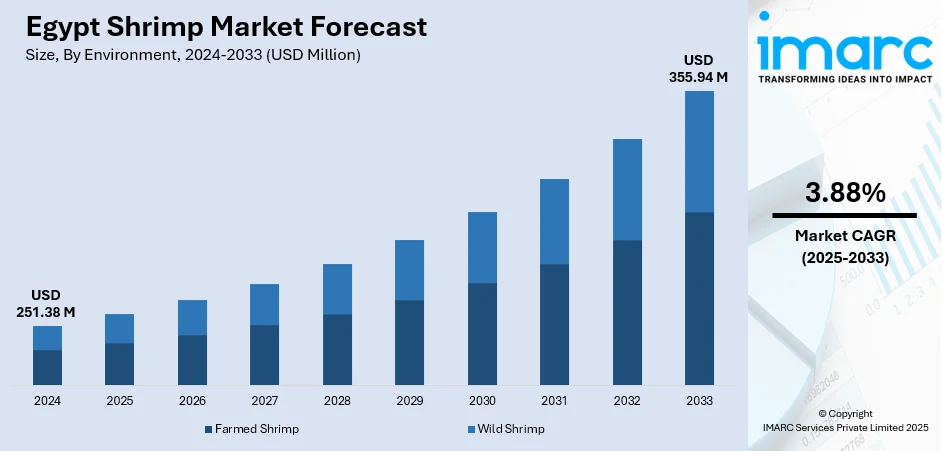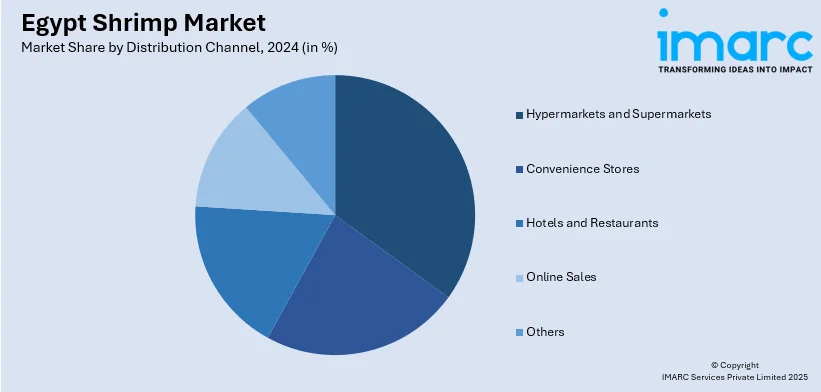
Egypt Shrimp Market Size, Share, Trends and Forecast by Environment, Species, Shrimp Size, Distribution Channel, and Region, 2025-2033
Egypt Shrimp Market Overview:
The Egypt shrimp market size reached USD 251.38 Million in 2024. The market is projected to reach USD 355.94 Million by 2033, exhibiting a growth rate (CAGR) of 3.88% during 2025-2033. The market is experiencing significant growth, driven by increasing international demand and advancements in farming technologies. Sustainable farming practices and improved production methods continue to enhance the quality of shrimp, supporting Egypt shrimp market share in global seafood exports.
|
Report Attribute
|
Key Statistics
|
|---|---|
|
Base Year
|
2024 |
|
Forecast Years
|
2025-2033
|
|
Historical Years
|
2019-2024
|
| Market Size in 2024 | USD 251.38 Million |
| Market Forecast in 2033 | USD 355.94 Million |
| Market Growth Rate 2025-2033 | 3.88% |
Egypt Shrimp Market Trends:
Increasing Global Demand for Egyptian Shrimp
Egypt has observed a consistent increase in demand for shrimp, both from its local market and foreign consumers. Being situated in the middle, linking Europe, Asia, and the Middle East, the country has emerged as one of the principal players in the international seafood trade. With increasing global consumption of seafood, Egypt's shrimp industry has grown impressively, making a positive economic impact for the country. This development has been spurred by a number of factors, such as enhanced farming techniques, improved infrastructure, and the evolution of technology, all of which have enhanced Egypt's capacity to produce and export. Due to increased demand worldwide, shrimp farms around the country are going greener. As global consumers increasingly focus on environmentally sustainable purchasing, Egypt has come a long way in minimizing water consumption and reducing the ecological footprint of its aquaculture activities. Government assistance has also helped push the industry forward, promoting the opening of new farms and overall output increases. These mutual efforts see Egypt continue to be a competitive player in the international shrimp market, with future growth expected in the coming years.

To get more information on this market, Request Sample
Modernization of Shrimp Farming Methods
The Egypt shrimp market growth is being revolutionized by advances in technology and sustainability. More conventional systems of shrimp farming are being replaced by more sophisticated ones, like RAS, which are more efficient and provide better management of water. These systems use less water, maintain the best conditions for optimal shrimp growth, and reduce the environmental impacts of farming. This technology change not only enhances sustainability but also results in increased productivity levels. Egyptian shrimp farms are increasingly embracing automation at different production stages. Automated feeding, water quality monitoring, and climate control devices ensure that the shrimp are being reared under the best possible conditions, cutting down on costs and enhancing farm performance as a whole. With the global market prioritizing the traceability and quality of seafood increasingly, Egypt has progressed considerably in the adoption of biosecurity protocols and sophisticated disease control. Not only do these new technologies make shrimp healthier, but they also help ensure that Egyptian shrimp are internationally compliant. As the industry further modernizes, Egypt's position in the international shrimp market will almost certainly be bolstered, reaping benefits from rising production as well as enhanced sustainability measure.
Egypt Shrimp Market Segmentation:
IMARC Group provides an analysis of the key trends in each segment of the market, along with forecasts at the country and regional level for 2025-2033. Our report has categorized the market based on environment, species, shrimp size, and distribution channel.
Environment Insights:
- Farmed Shrimp
- Wild Shrimp
The report has provided a detailed breakup and analysis of the market based on the environment. This includes farmed shrimp and wild shrimp.
Species Insights:
- Penaeus Vannamei
- Penaeus Monodon
- Macrobrachium Rosenbergii
- Others
The report has provided a detailed breakup and analysis of the market based on the species. This includes penaeus vannamei, penaeus monodon, macrobrachium rosenbergii, and others.
Shrimp Size Insights:
- <21
- 21-25
- 26-30
- 31-40
- 41-50
- 51-60
- 61-70
- >70
The report has provided a detailed breakup and analysis of the market based on the shrimp size. This includes <21, 21-25, 26-30, 31-40, 41-50, 51-60, 61-70, and >70.
Distribution Channel Insights:

- Hypermarkets and Supermarkets
- Convenience Stores
- Hotels and Restaurants
- Online Sales
- Others
A detailed breakup and analysis of the market based on the distribution channel have also been provided in the report. This includes hypermarkets and supermarkets, convenience stores, hotels and restaurants, online sales, and others.
Regional Insights:
- Greater Cairo
- Alexandria
- Suez Canal
- Delta
- Others
The report has also provided a comprehensive analysis of all the major regional markets, which include Greater Cairo, Alexandria, Suez Canal, Delta, and others.
Competitive Landscape:
The market research report has also provided a comprehensive analysis of the competitive landscape. Competitive analysis such as market structure, key player positioning, top winning strategies, competitive dashboard, and company evaluation quadrant has been covered in the report. Also, detailed profiles of all major companies have been provided.
Egypt Shrimp Market News:
- April 2025: Dr. Mohamed Abdel Rahim highlighted Egypt’s potential to expand shrimp farming, particularly in desert regions using saline groundwater. This development aims to enhance shrimp production efficiency, boosting the Egypt shrimp industry. The initiative is expected to increase local shrimp supply, driving market growth and sustainability.
Egypt Shrimp Market Report Coverage:
| Report Features | Details |
|---|---|
| Base Year of the Analysis | 2024 |
| Historical Period | 2019-2024 |
| Forecast Period | 2025-2033 |
| Units | Million USD |
| Scope of the Report |
Exploration of Historical Trends and Market Outlook, Industry Catalysts and Challenges, Segment-Wise Historical and Future Market Assessment:
|
| Environments Covered | Farmed Shrimp, Wild Shrimp |
| Species Covered | Penaeus Vannamei, Penaeus Monodon, Macrobrachium Rosenbergii, Others |
| Shrimp Sizes Covered | <21, 21-25, 26-30, 31-40, 41-50, 51-60, 61-70, >70 |
| Distribution Channels Covered | Hypermarkets and Supermarkets, Convenience Stores, Hotels and Restaurants, Online Sales, Others |
| Regions Covered | Greater Cairo, Alexandria, Suez Canal, Delta, Others |
| Customization Scope | 10% Free Customization |
| Post-Sale Analyst Support | 10-12 Weeks |
| Delivery Format | PDF and Excel through Email (We can also provide the editable version of the report in PPT/Word format on special request) |
Key Questions Answered in This Report:
- How has the Egypt shrimp market performed so far and how will it perform in the coming years?
- What is the breakup of the Egypt shrimp market on the basis of environment?
- What is the breakup of the Egypt shrimp market on the basis of species?
- What is the breakup of the Egypt shrimp market on the basis of shrimp size?
- What is the breakup of the Egypt shrimp market on the basis of distribution channel?
- What is the breakup of the Egypt shrimp market on the basis of region?
- What are the various stages in the value chain of the Egypt shrimp market?
- What are the key driving factors and challenges in the Egypt shrimp market?
- What is the structure of the Egypt shrimp market and who are the key players?
- What is the degree of competition in the Egypt shrimp market?
Key Benefits for Stakeholders:
- IMARC’s industry report offers a comprehensive quantitative analysis of various market segments, historical and current market trends, market forecasts, and dynamics of the Egypt shrimp market from 2019-2033.
- The research report provides the latest information on the market drivers, challenges, and opportunities in the Egypt shrimp market.
- Porter's Five Forces analysis assists stakeholders in assessing the impact of new entrants, competitive rivalry, supplier power, buyer power, and the threat of substitution. It helps stakeholders to analyze the level of competition within the Egypt shrimp industry and its attractiveness.
- Competitive landscape allows stakeholders to understand their competitive environment and provides an insight into the current positions of key players in the market.
Need more help?
- Speak to our experienced analysts for insights on the current market scenarios.
- Include additional segments and countries to customize the report as per your requirement.
- Gain an unparalleled competitive advantage in your domain by understanding how to utilize the report and positively impacting your operations and revenue.
- For further assistance, please connect with our analysts.
 Request Customization
Request Customization
 Speak to an Analyst
Speak to an Analyst
 Request Brochure
Request Brochure
 Inquire Before Buying
Inquire Before Buying




.webp)




.webp)












